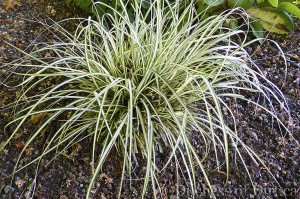 Carex oshimensis ‘Evergold’
Carex oshimensis ‘Evergold’
(KAIR-ecks oh-shih-MEN-siss)
syn. Carex morrowii ‘Aureovariegata’
Family: Cyperaceae
Common name: variegated Japanese sedge
Zone: 5 – 9
Height: 10 – 16 in (25 – 40 cm)
Spread: 10 – 16 in (25 – 45 cm)
Aspect: partial shade; full shade
Soil: medium; moist; well-draining
Water: moderate; regular
Description: A slow growing, evergreen perennial grass with a dense, clump-forming habit. Narrow leaves with creamy yellow centres edged in green form a ground-hugging, arching fountain shape. Insignificant brown flower spikes on triangular stems appear in summer.
Special Notes: Native to the rocky slopes and dry wooded areas of Honshu Island, Japan where it is commonly known as Oshima kan suge. A low maintenance, fine-textured grass which tolerates moist areas such as beside ponds but needs good drainage. Most references place this in at least partial shade but it does well in full sun with regular water. Foliage can be cut back to a low mound in late winter to rejuvenate the leaves. Spreads by rhizomes. Propagate by division in early spring or autumn. Relatively few pests and disease problems. Deer and rabbit resistant.
In our Zone 7a garden: Several clumps of ‘Evergold’ dot the landscape in my front garden as this grass species does exceptionally well in competition with the roots of my chestnut tree (Aesculus hippocastanum) and silverleaf maple (Acer saacharinum). As for deer resistance, I cannot confirm this fact as our garden is completely fenced against buffet-hunting ungulates. However, there are rabbits in the neighbourhood which can sneak in but they completely shun this grass, preferring to nibble on another grass called, Hakonechloa macra ‘All Gold’, my tulips and hosta leaf tips instead.
RHS Award of Garden Merit 1993
Posted on April 27, 2013; updated on October 30, 2024
